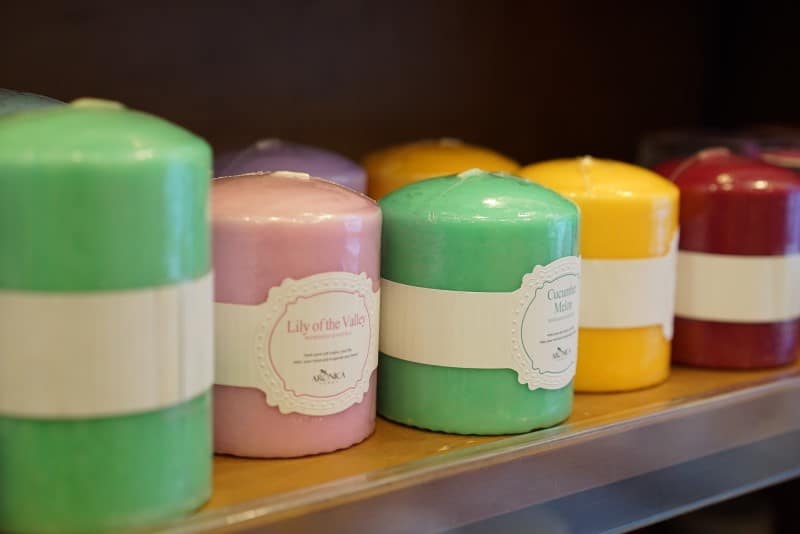At some point or another, most people who like candles will end up contemplating whether white candles or colored candles burn faster. Intuitively, many people think that white candles would burn more quickly because the wax used to make them doesn’t have any extra dye added to it. However, the truth of the matter might surprise you.
White candles without any coloring or dyes tend to burn slower than colored candles. Colored candles usually have a higher concentration of chemicals, additives, and dyes, which burn faster than pure wax. However, the difference in how quickly each type of candle burns is relatively small.
Whether you are doing a bit of research for a science project or just wanting to get a candle that will last you a long time, knowing whether white candles burn faster than colored candles can be surprisingly helpful knowledge.

There are, however, many more variables and nuances that determine how quickly a candle burns, so keep on reading, and let’s just get right into it!
Do White Candles Burn Faster Than Colored Candles?
If you asked a random person whether white candles or colored candles burn faster, they would probably say that white candles burn more quickly. This answer seems to be just common sense at work because you are likely to assume pure wax would burn faster than wax that has added color.
However, the opposite is actually true. Colored candles tend to burn more quickly than white candles that don’t have any added dyes.
The main reason for colored candles to burn faster than white candles is the added color, but it works oppositely than you might think. The dyes and additives in colored candles are often made of chemicals that burn more quickly than wax, making the entire colored candle burn faster.
So you might be thinking, “that thoroughly answers the question; colored candles always burn faster than white candles,” but it’s not as simple as that. Of course, there are many exceptions to this rule, and many variables can affect how fast a candle burns.
However, putting many exceptions and special cases out of the way, the vast majority of commercially produced colored candles will burn slightly faster than white candles.
What Variables Affect How Fast a Candle Will Burn?
I have consistently said that colored candles will burn faster than white candles throughout this article because the additives and dyes burn quicker. However, I also mentioned that this is not always the case due to the many unknown variables and influences that can affect how fast a particular candle burns.
In some situations, white candles with zero dye may burn more quickly than colored candles in the same environment. There are just so many variables that it is impossible to say with absolute certainty, “colored candles will ALWAYS burn faster than white ones.” There are always going to be exceptions that will cause white candles to burn faster in some scenarios.
In the next few sections, I’ll go over some of the primary variables that affect how fast a candle burns and hopefully shed some light (get it!) on some of the reasons why candles burn at different rates.
The Size and Type of Wick
One of the biggest influences on how fast a particular candle will burn is the wick. The wick is where the actual flame is located, so naturally, it will largely control how hot and large the fire gets.
In general, a larger and thicker wick will make the candle burn more quickly. The wick’s larger surface area will allow the flame to get bigger, and subsequently, hotter. If you want your candle to last as long as possible, a smaller wick will usually be your best bet, although they can lead to uneven melting on larger candles.
The Type of Wax Used to Make the Candle
You can make candles out of various wax types—some of the most popular ones being soy wax, paraffin, and beeswax. Each type of wax has its own traits, strengths, and weaknesses, but some excel more than others in the realm of burning for a long time.
In general, it is a good idea to get a harder wax to ensure your candle lasts as long as possible. Examples of hard wax are beeswax and paraffin wax. Soy wax is on the softer end of the scale, making it burn faster, and candles made of it won’t last as long as ones made of beeswax or paraffin wax.
Dyes and Color Additives
As I mentioned earlier, the dyes and additives used to make colored candles can sometimes make the candle burn slower or faster. In most cases, the dyes and color additives used are high in chemicals that burn quite quickly, making most colored candles burn faster than white candles.
However, the amount of dye and color additives used in most colored candles to give them their vibrance is actually relatively low. This means that, while colored candles will burn slightly faster than white ones, they aren’t faster by much. Unless you’re meticulously timing or measuring a colored and white candle side by side, you usually won’t even notice a difference.
Scents and Essential Oils
Like the dyes and color additive that we just talked about, scents and essential oils added to candles can affect how long they burn. If you have a candle that has too much essential oil or other scents, there is a chance that it can clog up the wick and hinder the scents from spreading and the candle from burning properly.
If you hinder the wick from burning correctly for any reason, it will result in the candle not burning as efficiently or for as long. Putting too much scent or essential oil into a candle usually isn’t a problem unless you are making your own candles, but it is still something to keep in mind just in case.
Any Other Additives Such as Wax Hardeners
In addition to color additives, essential oils, scents, and dyes, some candles contain more additives such as wax hardeners and a host of others. While most of these extra additions to a candle are usually for a good reason, some of them have tradeoffs in the form of a faster burn time for your candle.
In most cases, you want a candle that will last as long as possible, so it is a good rule of thumb to steer far away from any extra additives in your candles if at all possible. However, sometimes the benefits are better than the downsides, so make sure to look at the particular ingredient and what it is doing to your specific candle.
The Environment Where You Burn the Candle
Another considerable influence that can drastically change how long a candle can burn for is its environment. Everything from the air quality, wind, and temperature all have at least a small impact on how long a candle will burn.
One of the most impactful elements of an environment that will impact a candle the most is the wind. To ensure your wick, and therefore you candle, can burn for as long as possible, ensure there is minimal to zero wind in the area that can impact your candle.
The Age and Condition of the Candle
It might seem irrelevant, but the age of your candle can heavily influence how long it can burn. If you store your candles properly, their age will make minimal impact on how long they will burn; however, if they are stored improperly, it can significantly cut down how long they will stay lit.
Candles tend to become dry and brittle if they are left for an extended period of time out in the open air. It is essential to make sure this doesn’t happen, so storing them in a sealed container in a cold or room temperature place is your best bet for keeping candles long-term.
